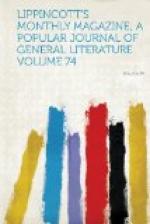Social and political questions like this point to a vast field of inquiry. For its proper cultivation the exposition provides data additional to those heretofore available. They should be used as far as possible upon the spot. At least, they can be examined, collated and prepared for full employment. To this end, meetings and discussions held by men qualified by intellect and study to deal with them are the obvious resort. There is room among the two hundred judges for some such men, but the juries are little more numerous than is required for the examination of and report on objects. For more abstract inquiries they will need recruits. These should be supplied by the leading philosophical associations of this country and Europe. The governments have all an interest in enlisting their aid, and the Centennial Commission has done what in it lay to promote their action. Ethnic characteristics, history, literature, education, crime, statistics as a science, hygiene and medicine generally are among the broad themes which are not apt to be adequately treated by the average committee of inspection. So with the whole range of the natural sciences. Dissertations based on the jury reports will doubtless be abundant after a while, but those reports themselves, being limited in scope, will not be as satisfactory material as that which philosophic specialists would themselves extract from direct observation and debate upon the ground.
For the study of the commanding subject of education the provision made at the present exhibition is exceptionally great. In bulk, and probably in completeness, it is immeasurably beyond the display made on any preceding occasion. The building erected by the single State of Pennsylvania for her educational department covers ten or eleven thousand square feet, and other States of the Union make corresponding efforts to show well in the same line. The European nations all manifest a new interest in this branch, and give it a much more prominent place in their exhibit than ever before. The school-systems of most of them are of very recent birth, and do not date back so far as 1851. The kingdom of Italy did not exist at that time or for many years after, yet we now see it pressing for a foremost place in the race of popular education, and multiplying its public schools in the face of all the troubles attendant upon the erection and organization of a new state.
The historian will find aliment less abundant. A century or two of Caucasian life in America is but a thing of yesterday to him, and, though far from uninstructive, is but an offshoot from modern European annals. For all that, he finds himself on our soil in presence of an antiquity which remains to be explored, and which clamors to be rescued from the domain of the pre-historic. It has no literary records beyond the scant remains of Mexico. It writes itself, nevertheless, strongly and deeply on the face of the land—in mounds, fortifications




